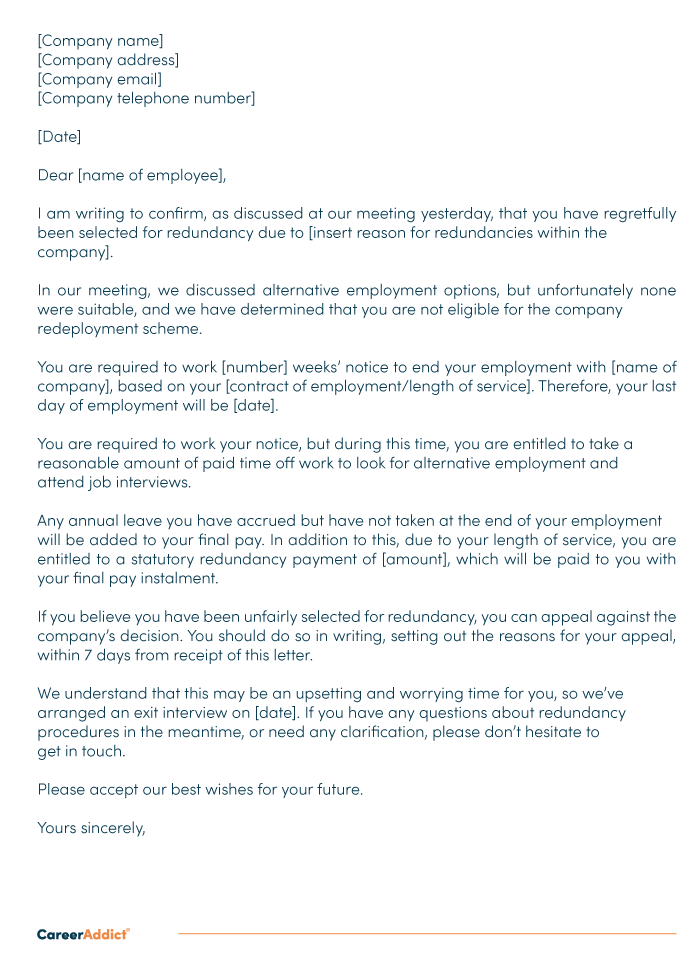Your Rights to Redundancy If Company Goes Bust: UK Employee Protections
Your Rights to Redundancy If Company Goes Bust: UK Employee Protections
Blog Article
Investigating the Interplay Between Business Redundancy and Organizational Flexibility for Future Development
In the vibrant landscape of today's service globe, the complex relationship between company redundancy and business flexibility emerges as a crucial aspect for sustained development and success. Firms typically deal with the challenge of striking a fragile equilibrium between preserving a level of redundancy to reduce dangers and cultivating versatility to respond promptly to the ever-evolving market demands.
Value of Firm Redundancy
Business redundancy is an essential aspect that improves organizational strength and minimizes functional threats. By including redundancy measures within the organizational structure, firms can better stand up to unforeseen interruptions and fluctuations in the organization atmosphere. Redundancy offers as a critical buffer, allowing business to adjust and react properly to unanticipated difficulties without compromising vital operations.
One secret aspect of the significance of company redundancy is its role in making certain continuity throughout times of situation. When confronted with sudden modifications or emergencies, redundant systems, sources, or workers can step in to preserve essential functions and avoid prevalent disturbances. This continuity not only safeguards the firm's online reputation and client depend on yet likewise reduces monetary losses and operational downtime.

Methods for Business Versatility

One more important technique is buying modern technology and framework that can support adaptability and scalability. Implementing electronic tools, automation, and data analytics can enhance operations, improve performance, and offer beneficial insights for informed decision-making. In addition, developing adaptable business frameworks that enable quick modifications to market dynamics and consumer requirements is vital for staying competitive in a quickly evolving environment. By proactively determining prospective disruptions and opportunities, companies can proactively prosper and adapt in an ever-changing service landscape.
Harmonizing Redundancy and Flexibility
Attaining a harmonious balance in between functional redundancy and business adaptability is extremely important in navigating the complexities of a dynamic organization environment. Redundancy within a company supplies a safeguard, making sure connection and stability in procedures. However, an excess of redundancy can lead to ineffectiveness and prevent flexibility to changing market conditions. On the various other hand, business adaptability enables firms to react without delay to exterior disturbances and confiscate brand-new chances. Striking the appropriate balance in between redundancy and adaptability is a delicate process that requires a deep understanding of the company's objectives, market dynamics, and threat resistance.
To accomplish this balance, companies need to carry out routine evaluations of their procedures to recognize locations where redundancy is essential for risk reduction and where flexibility can drive innovation and development. Implementing versatile structures, fostering a culture of continuous discovering and enhancement, and motivating open communication throughout all degrees of the company are crucial methods to balance redundancy and adaptability effectively. By aligning these 2 Learn More important aspects, companies can place themselves for sustainable development and success in an ever-changing company landscape.
Study on Adaptation Success
In taking a look at instances of effective organizational adaptation, it comes to be obvious that the interplay between functional redundancy and versatility is a specifying element in forming resilient organizations. A DVD rental click this service, Netflix demonstrated impressive adaptability by transitioning right into a streaming system when digitalization disrupted the industry. These case studies highlight the significance of operational redundancy coupled with organizational versatility in fostering long-term growth and competitiveness.
Building Resilience for Future Growth
Building strength for future growth needs a tactical positioning of operational processes with market characteristics and emerging patterns. Companies should adjust to changing settings by fostering a culture of flexibility, development, and continuous renovation.
Furthermore, cultivating solid relationships with stakeholders, such as clients, workers, vendors, and the area, is important for weathering uncertainties and maintaining trust fund and support throughout unstable times. Efficient interaction and openness play an important role in building durability, as they assist straighten assumptions and assist in collaboration in browsing unpredictabilities.
In addition, organizations need to prioritize learning and growth campaigns to upskill workers and furnish them with the required tools to adjust to transforming conditions. By buying their labor force, business can improve their versatility and dexterity, inevitably strengthening their strength for sustainable future growth.
Conclusion

In the dynamic landscape of today's organization world, the complex partnership in between firm redundancy and organizational flexibility arises as an important factor for sustained growth and success. Business usually face the challenge of striking a delicate balance between maintaining a level of redundancy to mitigate risks and fostering adaptability to respond swiftly to the ever-evolving market demands.To achieve this balance, companies need to perform normal analyses of their procedures to determine areas where redundancy is required for danger mitigation and where adaptability can drive technology and development.In final thought, the interplay in between firm redundancy and business versatility is important for future growth. Structure strength with a combination of redundancy and adaptability will certainly ensure that companies are prepared for the challenges of the future.
Report this page